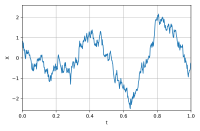Brownian noise

Have you ever seen dust particles moving around in the air? It looks like they are shaking and moving around randomly. This is kind of how Brownian noise works.
Everything in the world is made up of tiny particles called atoms, and these atoms are constantly moving around randomly. Brownian noise happens when these atoms bump into each other in a gas or liquid, which creates little vibrations that we can hear as noise.
Imagine you are at a crowded playground, and people are walking around and bumping into each other. The more people that are moving, the louder the noise becomes. It's the same with atoms - the more atoms in a gas or liquid, the louder the Brownian noise becomes.
Even though we can't see atoms or hear the noise they create individually, scientists have special tools that can pick up on this random noise. This can be helpful in certain situations, like when measuring the movement of tiny particles like cells.
In summary, Brownian noise is the random movement of atoms in a gas or liquid, which creates small vibrations that we can hear as noise. Think of it like crowded playground where everyone is bumping into each other, making lots of noise.
Everything in the world is made up of tiny particles called atoms, and these atoms are constantly moving around randomly. Brownian noise happens when these atoms bump into each other in a gas or liquid, which creates little vibrations that we can hear as noise.
Imagine you are at a crowded playground, and people are walking around and bumping into each other. The more people that are moving, the louder the noise becomes. It's the same with atoms - the more atoms in a gas or liquid, the louder the Brownian noise becomes.
Even though we can't see atoms or hear the noise they create individually, scientists have special tools that can pick up on this random noise. This can be helpful in certain situations, like when measuring the movement of tiny particles like cells.
In summary, Brownian noise is the random movement of atoms in a gas or liquid, which creates small vibrations that we can hear as noise. Think of it like crowded playground where everyone is bumping into each other, making lots of noise.
